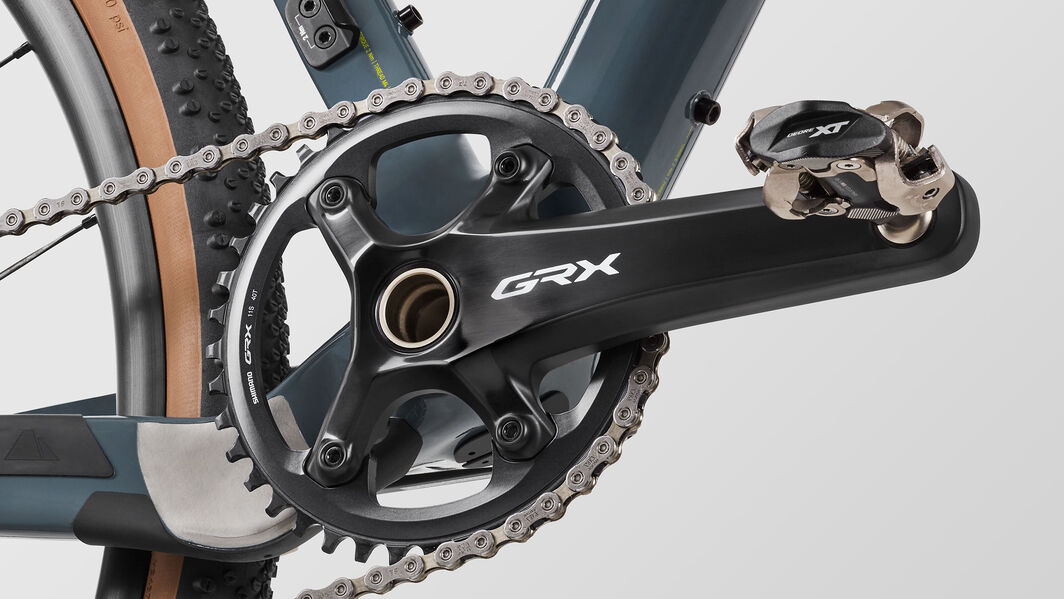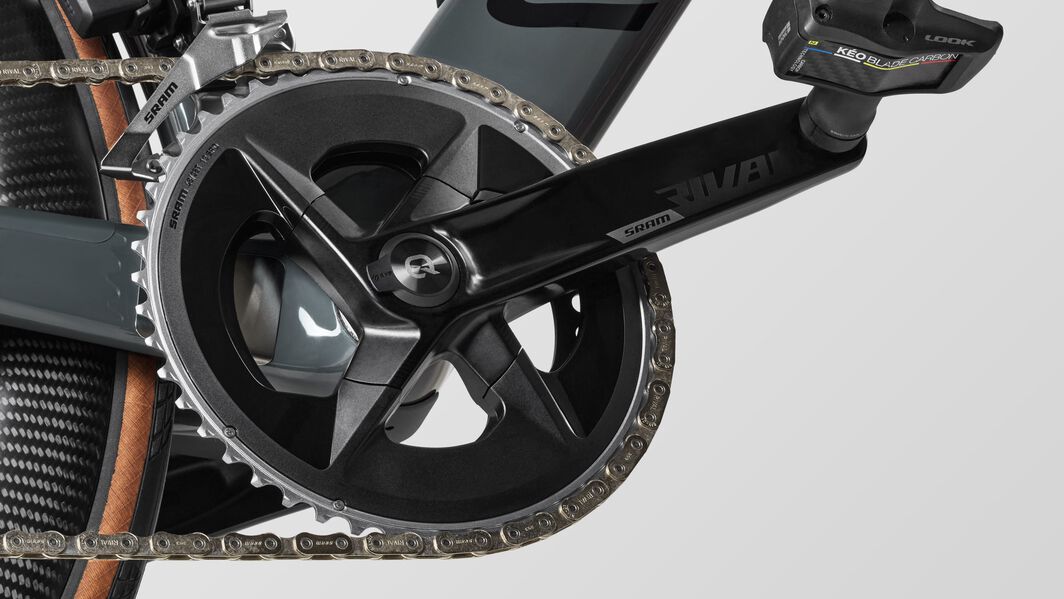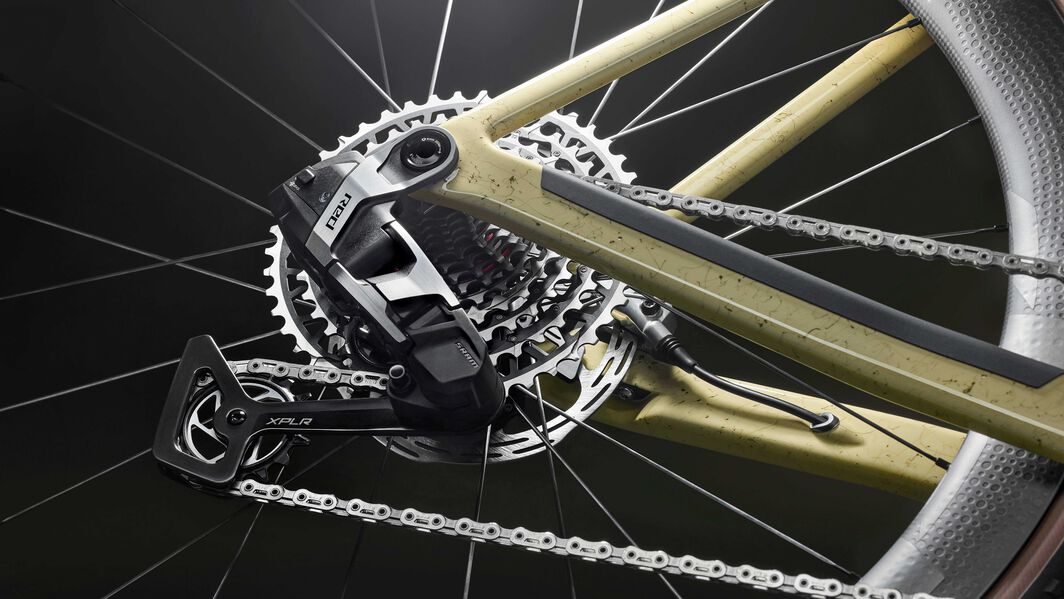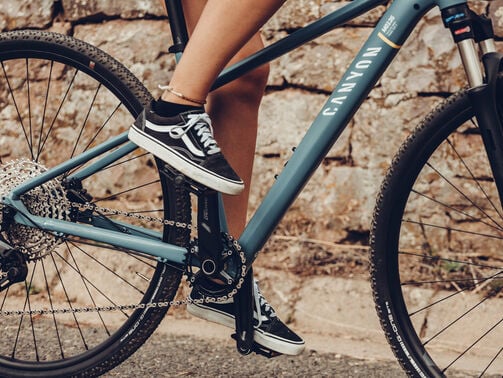Bike gear ratios decoded: Find your perfect setup
Master cycling gear ratios and dial in your best gearing, from steep climbs to flat sprints.


Understanding bicycle gearing means smoother, more comfortable riding and better performance. The numbers can seem confusing, but whether you're smashing hills on your Canyon Ultimate or powering across the flats on the Aeroad, using the right gear ratio for bikes makes all the difference. This guide will help you decode gear ratios and compare bike gearing options to find the perfect setup for your ride style.
Contents
What are bike gear ratios?
In simple terms, gear ratios refer to the relationship between your front chainring teeth and rear cassette teeth. Understanding gear ratios removes the confusion when it comes to choosing gears that suit your riding style.
Key concepts:
- Gear Ratio Definition: Front teeth ÷ rear teeth.
- Higher Ratio: Harder to pedal, but more speed.
- Lower Ratio: Easier to pedal, but slower pace.
Understanding bicycle gears helps you ride longer and smarter without grinding uphill or spinning out on flats. The right gear ratios will depend on your fitness level, the terrain you are riding on, and what your cycling ambitions are.
How to calculate bike gear ratio for any setup
Understanding your gear ratio helps you maximise performance and riding comfort, whether you're climbing hills, cruising flats, or just want to find that ideal cadence. It’s a key factor in how hard or easy it feels to pedal. Calculating gear ratio isn’t complicated, and once you know how, you can apply it to any bike setup. Here's how to do it.
Identify your chainring teeth
Knowing how many teeth are on your chainrings is key to understanding what your bike’s gear ratio is. Chainrings are the large, toothed rings attached to the crankset, where your pedals connect, and they drive the chain as you pedal. More teeth on the chainring means it’s harder to pedal but you have more top-end speed; fewer teeth mean easier pedaling, which is great for climbs. This number is the starting point for calculating your gear ratio. Here’s how to find out:
- Check the crankset-chainrings often have the teeth numbers printed on them (e.g., 50T, 34T).
- Typical ranges: road (50–34T), gravel (48–32T), MTB (30–36T).
Tip: If unmarked, count them manually or take a photo and zoom in.
Note your cassette teeth
A cassette refers to the cluster of metal sprockets attached to your rear wheel hub. Each row of teeth represents a different gear. There are a variety of different cassette sizes. Here are some typical examples:
- Road: 11–28T, 11–32T, 11-34T
- Gravel: 11–34T, 11–40T
- MTB: 11–42T, 10–50T
Just like chainrings, the size of your cassette also plays a big role in how your bike feels to ride. A cassette with a wide range (like 11–34T or 10–50T) gives you more low gears, which makes climbing hills easier. Smaller cassettes (like 11–28T) offer tighter spacing between gears, which is great for smoother shifts and maintaining speed on flat roads. The combination of your chainring and cassette determines your overall gear ratio, directly affecting your pedaling effort, speed, and comfort across different terrain.

Why bicycle gearing matters for different terrains
Fast rides across flat terrain will usually be suited to higher gear ratios. Conversely, road rides with significant climbing (and virtually all mountain bike rides) are best suited to lower (easier) gear ratios. What are the real-world impacts of gearing choice?
- Flats: Higher ratios let you maintain speed with a steady cadence. Picture pedalling a big gear in a group on flat roads or reaching high speeds while still pedalling on fast descents.
- Hills: Lower ratios help you ‘spin’ while climbing. A higher cadence will help keep you fresher for longer. A 34T inner chainring with a large cassette such as an 11/34T will give you a 1:1 gear range along with smaller or easier gears to help you up the steepest mountain passes.
- Mixed terrain: A versatile gear range offers smooth transitions and helps control your speed. In this case, you want to be able to maintain a high speed on the flats while also having a wide range for climbs.
Using a gear ratio that’s well suited to your terrain and ride style will give you more confidence and leave you feeling fresher and stronger during your ride.
Comparing gear ratio for road bikes, mountain bikes, and gravel bike
Gear ratios vary significantly between road bikes, mountain bikes (MTB), and gravel bikes, with each designed for different terrain, ride styles, and performance needs. Understanding how chainring setups and cassette ranges differ across these bike types can help you choose the right gearing for your riding goals, whether you're climbing steep trails or cruising on fast, smooth roads.
| Bike type | Chainring setup | Cassette Range | Typical Ratios |
|---|---|---|---|
| Road | Standard (53/39), Compact (50/34), Semi-compact (52/36) | 11–28T, 11–34T | 1.5–2.5 (flats) to ~1.0 (climbs) |
| MTB | Mostly 1×30–36T | 11–42T, 10–50T | 0.6–2.5 (steep climbs to flats) |
| Gravel | 1× or 2× (48/32, 46/30) | 11–36T, 10–44T | 0.8–2.5 (balanced range) |
As shown above, road bikes typically use higher gear ratios for speed and efficiency on smooth surfaces. Mountain bikes prioritize low gear ratios for tackling steep, technical climbs, while gravel bikes strike a balance to offer versatility on mixed terrain. By comparing these setups, you can better understand what gearing will suit your riding needs and conditions best.
Road bike gearing (chainrings)
The chainrings you choose make a big difference in your ride efficiency and comfort. The ideal gearing for you depends on the type of terrain you ride and your fitness level. Here’s a quick guide to the most common road bike chainring configurations:
- Standard (54/40, 53/39, 48/35- SRAM ): Ideal for flat, high‑speed rides. Often favoured by elite racers.
- Semi-compact (52/36): An ideal combination for fast, flat rides and routes involving climbing.
- Compact (50/34): Though easier for climbing, this setup still allows for flat speed but may leave you “spinning out”, wishing you had a higher gear, on the fastest, steepest descents.
Your chainring choice should be dictated by the kind of riding you do most often. While standard setups may suit powerful riders on flat roads, compact and semi-compact options, like those found on the Canyon Endurace, offer more versatility for mixed or hilly terrain.

Mountain bike gearing
Mountain bike gearing has evolved significantly over the last decade. The dominant trend is now 1x drivetrains, where a single front chainring is paired with a wide-range rear cassette. This setup has mostly replaced older 2x and 3x systems due to its simplicity, lighter weight, and improved reliability on technical terrain.
With fewer components and no front derailleur, shifting becomes more straightforward and mechanical issues are less common. Modern wide-range cassettes, such as 10–51 tooth setups, offer enough range to handle steep climbs as well as fast descents. As a result, 1x drivetrains have become the standard choice for trail, enduro, and downhill bikes, while 2x systems that offer even lower gearing remain mostly in use for specific needs like bikepacking or long-distance cross-country rides.
Gravel bike gearing
Gravel gearing provides a mix of speed and off-road stability. In recent years, 1x or ‘mullet’ setups have become more popular. This sees a smaller single chainring paired with a wide-ranging rear cassette. The latest Canyon Grizl CF 7 uses a 40T single chainring and a 10-45T cassette. A 2x setup will use subcompact 48/32 or 46/30 chainrings paired with a 11–36 or wider cassette. Generally, gravel bike gear ratios sit between road and MTB and offer a balanced range for varied terrain.
Why 1x drivetrains are now standard:
- Simpler shifting: One shifter and no front derailleur to worry about.
- Lower weight: Fewer components help reduce overall bike weight.
- Less maintenance: Fewer moving parts usually equals less cleaning and adjustment.
- Better chain retention: Narrow-wide 1x chainrings reduce the incidence of dropped chains on rough trails.
What are wide-range cassettes and why they matter:
Wide-range cassettes typically have 11–46T, 11–50T, or even 10–52T sprockets. This gives you both super low gearing for climbing steep, technical trails and high enough gearing to pedal comfortably on descents and technical terrain.

Finding the best gearing for climbing and flat roads
Your gearing setup makes a big difference to your comfort and efficiency when riding. Whether you're grinding up steep hills or cruising on the flats, matching your gear ratios to the terrain is key. Riders who often tackle steeper or longer climbs will benefit from easier gearing, while those sticking to flat roads can prioritise speed. Below is a breakdown of what to look for depending on where you ride most.
Gearing on a road bike for steep climbs
- Aim for a lowest ratio around 1.0 or below.
- Use compact (50/34) or super‑compact (48/32) chainrings.
- Pair with 11–32 or 11–34T cassette for hills.
- Beginner riders should aim for ≤1.0; stronger riders might stick to compact setups.
Best gearing for speed on flats
If you mainly ride on flat terrain, your best bet is to select gears designed for speed and efficiency. Higher gear ratios allow you to maintain high speeds without spinning out. The right setup will help you hold a smooth, powerful cadence while covering ground quickly. Here's what to look for when choosing gears for flat rides.
- Opt for higher ratios- around 2.0–2.5+.
- Use standard chainrings (53/39 or 50/34) with tighter cassettes (11–25T, 11–28T).
- Keep cadence at ~70–100 rpm to balance speed and efficiency.
How personal cadence and fitness shape your ideal gear ratio
Are you a spinner or a big gear grinder? A seasoned mile-muncher or a weekend rider? Your preferred cadence style and overall cycling fitness , not just the terrain, will help determine the gearing that’s best for you. Some riders naturally spin faster, while others prefer to push harder at a slower cadence. Understanding your strengths and preferences can help you fine-tune your setup for a smoother and more efficient ride
- Preferred cadence (pedal rpm) guides your gear targets.
- Fitness level determines how hard you're comfortable pushing.
Self-assessment:
- Beginner: Low ratios (<1.0) makes everything smoother.
- Intermediate: Mix ratios, 1.0–2.0 works across various terrain.
- Advanced: Fine-tune your ratios in narrower increments for enhanced performance.

Single vs. multiple chainrings – which is right for you?
One of the key decisions when setting up or buying a bike is whether to opt for a 1x or 2x chainring setup. Each option comes with its own advantages and trade-offs, and the right choice depends on your riding goals, terrain, and personal preference. Here's a breakdown to help you decide which drivetrain setup suits you best.
Benefits of single chainring (1×)
- Simple, lightweight, low maintenance.
- Wide-range cassette offers a spread of gears.
- Good for MTB, gravel, and those seeking simplicity.
- Limitations: Wider gaps between gears, less top-end speed.
1x setups are ideal for riders who want simple reliability with fewer parts to manage. They're well suited for MTB, gravel, and mixed terrain. While they offer a wide gear range, the trade-off is bigger jumps between gears and slightly less top-end speed. If you value low maintenance and versatility, a 1x setup is a strong choice, but 2x chainrings may suit road riders who need more precise gearing.
Benefits of multiple chainrings (2×/3×)
While 1x setups are popular for their simplicity, multiple chainrings still offer key advantages. They provide more gearing options and smoother transitions, which can be helpful for maintaining an even cadence on varied terrain.
- Greater gear range.
- Better cadence control at every pace, thanks to finer jumps between gears. Ideal for road riding or mixed terrain where precision matters.
Multiple chainrings are a great choice for riders who want maximum gear range and smaller “jumps” between each gear. They’re particularly useful for road cycling or mixed terrain where maintaining an even cadence is important.
Pedal forward with confidence
You’ve now learned how to make sense of cycling gear ratios, and where each setup performs best. Want to power along the flats and maintain optimum speed? Go for higher gearing. Big plans to conquer the steepest climbs or navigate technical off-road terrain? A wide gear range with plenty of lower gearing will suit you well. With Canyon’s expertise in equipping optimal drivetrains and ratios for every ride style, you should have everything you need to ride in comfort and speed.
Aaand… that’s it - ride smarter, pedal smoother, and trust the gears to work with you 🚴♂️
Did this article help?
Thank you for your feedback
-
 About the author
About the authorCharles Graham-Dixon
Charlie is a copywriter, journalist, and passionate road and gravel rider, currently splitting his time between Madrid and London. With a deep love for cycling culture, Charlie brings words to life for brands and publications alike




